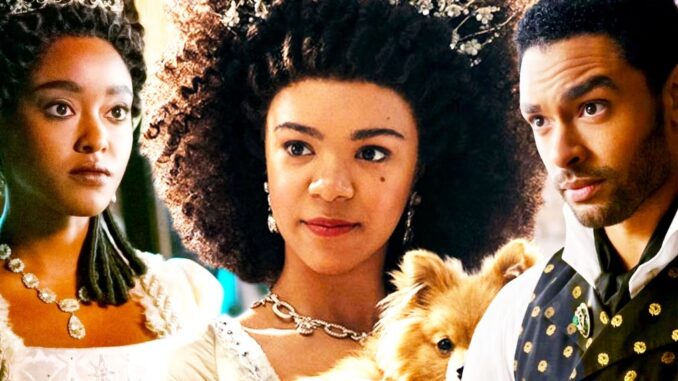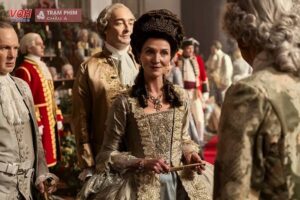
The Great Experiment In Queen Charlotte: What It Is, Does It Succeed & Was It Real?
Queen Charlotte delves further into The Great Experiment, which was first hinted at in Bridgerton season 1. Was it real? We break down the details.
Queen Charlotte: A Bridgerton Story establishes the Great Experiment, which is briefly mentioned in Bridgerton season 1. Created by Shonda Rhimes, Queen Charlotte is a prequel series set five decades before the start of Bridgerton, and follows the title character as she becomes a royal and marries King George III. But there’s a lot more on the line than just love for the pair.
Queen Charlotte was thrust into British society after her older brother Adolphus agreed to marry her off to King George III. What Queen Charlotte wasn’t aware of at the time was that she would become the unifying force for Britain, her marriage a bridge between high society and those who were previously alienated from engaging with it. While it was only mentioned in passing by Lady Danbury in Bridgerton season 1, Queen Charlotte delves further into The Great Experiment’s inner workings, and the struggles that emerge on account of such a major change.
The Great Experiment Was Integrating People Of Color Into Bridgerton’s High Society
The Great Experiment began with Queen Charlotte’s marriage to King George III. It was a starting point to integrate Black people and other people of color into Bridgerton’s religion and society at large. Agatha Danbury and her husband were given the titles of Lord and Lady Danbury, with the latter also joining Queen Charlotte’s royal court. In addition to titles, the King bestowed the new members of the nobility with land, status, and more wealth. This was considered an important step — the Royal family wanted to showcase that integrating people of color into a high society that could work. Queen Charlotte was more than a monarch, but the face of the Great Experiment.
Lady Danbury, however, was likely one of many who was descended from royalty before moving to Britain, and struggled with being accepted by Princess Augusta and other members of the Ton because of her race. It was the same for Lord Danbury, whose father was a friend to the previous King, but who was not treated with any dignity or respect before the change. The Great Experiment came with high stakes, especially considering the Ton’s treatment of Black people and other people of color was still not fully matching up with their societal rank. This was most obvious with Lady Vivian Ledger, Lady Violet Bridgerton’s mother, who voiced her disdain for The Great Experiment.

The Great Experiment In Queen Charlotte Was Considered A Success
Long before Bridgerton, The Great Experiment was considered a success as early as Queen Charlotte’s era. Although Princess Augusta and members of parliament didn’t believe The Great Experiment would stick, and were keen on backtracking on the agreement within a generation, it was ultimately Queen Charlotte who stood behind it. In her position, Queen Charlotte, despite going through a lot personally, wanted to solidify the position of the Ton’s newest members. But it was Lady Danbury who fought the hardest to ensure that her son would inherit his father’s title and wealth in the aftermath of his death, as would all the people of color in the Religion be able to do in the future.
With so much back-and-forth during The Great Experiment’s early stages, Queen Charlotte’s ending celebrates the union of not only Charlotte and George, but of their society as well. What’s more, Bridgerton confirms The Great Experiment worked out, with the Ton as diverse as ever, Lady Danbury’s title remains intact, and Simon Basset succeeds his father as the Duke of Hastings. The Ton had a renewed sense of energy and relationships — romantic and otherwise — bloomed in the years after Queen Charlotte and King George III’s marriage, which changed the world of Bridgerton forever.
Bridgerton True Story: Was Queen Charlotte’s Great Experiment Real?
Queen Charlotte’s Great Experiment was not real, as the show and Bridgerton are historical fantasies that borrow from the eras in which they are set. In reality, Black people and other people of color were not fully integrated or accepted into British society so early on, and not to the degree that Queen Charlotte suggested. While there were approximately 20,000 Black people living in Britain during the Regency era, the majority of them weren’t members of the aristocracy, but the working class, while some were enslaved.
There were, however, exceptions. Dido Belle, who was portrayed by Gugu Mbatha-Raw in Amma Asante’s Belle, grew up in high society, while a rare few families did own land (via Reclaiming Jane). That said, Black people were especially not treated well, even if they were members of the aristocracy. As one example, Dido Belle wasn’t allowed to have dinner with guests at Lord Mansfield’s home where she grew up.
